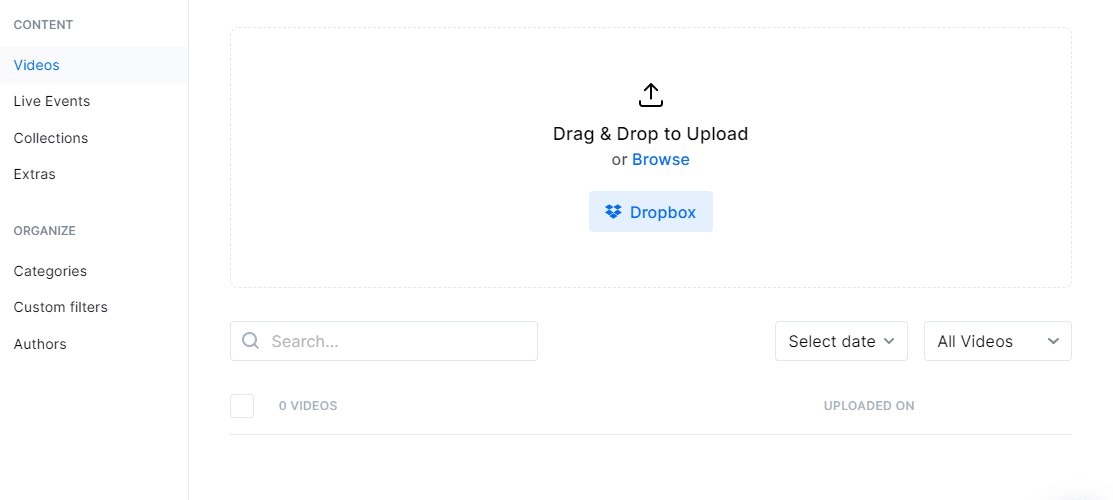Videos get more attention than written content or images and consequently leave an impact on the viewer. Adding video to your website can increase your search rankings on Google. Additionally, adding explainer videos of your product or service helps the consumer understand it better.
On the other hand, if you are an entrepreneur or a freelancer producing video content, you need to look for several things such as monetization tools, marketing tools, CDN, etc, before selecting the right platform to host your content. Let’s dig deeper into the basic capabilities that every video platform must provide.
Video Platforms Features And Capabilities You Need To Look Out For
Before choosing a video platform, there are a few things that you cannot overlook.
Accessibility and User Friendly
Every video platform must make it extremely simple for even novice users to get started, which means it should be cloud-based and does not require additional tech support to set up. You should be able to upload, publish and share videos within minutes. The security and tracking options must be in-built rather than being an add-on.
Video Creation Tools
Though video content is engaging by nature, you need to make it more interactive by using video creation tools provided by your video platform, such as customizable player, embed options, speaker notes, bios, searchable transcripts, etc.
Live Streaming Capabilities
Live streaming is the most economical medium to connect with audiences interactively. The video platform you choose must deliver your video without any latency. The on-demand video should be available within a few hours for you to distribute.
Analytics & Security
An ideal video platform provides security features that include IP restrictions, domain restrictions, registration pages with password protection, guestlist functionality so that you know who has access to your content.
A video platform must provide actionable analytics on key metrics such as performance data, view rate, completion rate, demographics, graphs, downloadable CSV, report sharing and scheduling, and summary data.
A reliable video platform gives you robust analytics and in-depth insight into viewer behavior and video performance. With that, let’s look at the top three video platforms available on the internet.
| Top Video Platforms | Features | ||||
|---|---|---|---|---|---|
| Video hosting features | Security | Analytics | Marketing and monetization tools | UI | |
| Uscreen | ★★★★☆ | ★★★★☆ | ★★★★★ | ★★★★★ | |
| Vimeo | ★★★★★ | ★★★★☆ | ★★★★☆ | ★★★★☆ | ★★★★★ |
| Dacast | ★★★★★ | ★★★★★ | ★★★★★ | ★★★☆☆ | |
Frequently Asked Questions About Online Video Platforms
Here are a few questions that people frequently ask about online video platforms.
What is a video platform?
Video hosting services provide video platforms that enable the users to store, upload, deliver video content and leverage it for monetization or marketing purposes like conversion, advertising, lead generation, etc.
Where can I host videos for free?
Vimeo, Wistia, and Youtube contain free plans to host videos.
How do I improve my social video strategy?
Here are a few things you can do to enhance your reach via videos:
- Optimize your setup by choosing the proper lighting, camera position, background, and body language.
- Include a hook in your videos within the first two seconds.
- Share important information very early on in the video.
- Make it viewable without sound as well by including descriptive images, infographics, and expressive body language.
- Include closed captions and vary the shots in the video.
- In the end, you should close with a strong call to action and a supporting copy.
These best practices may work for you, however, you must tweak them when your video requires.
1. Uscreen.tv
You find video hosting, streaming, monetization, OTT apps, website, end-user support, and many other things in a single place. Uscreen is loaded with features that enable you to create and scale your video delivery service.
It lets you set up your storefront and customize your website according to your brand. However, the landing pages are no comparison to the dedicated landing page builder like Leadpages or Unbounce that provide professional templates for different use cases.
Multiple monetization and marketing tools like subscriptions, rentals, coupons, promo codes, etc are available to attract viewers.
Unique features:
- Leadzen lets you create a full-fledged marketing funnel inside Uscreen’s platform, including setting up special pricing terms, automated emails, etc.
- It uses Akamai for highly scalable performance, storage capacity, and an uninterrupted streaming facility for the audience.
- It provides a seamless user experience while setting up a video subscription service.
- You can monetize live streams and recorded VOD with the PPV model.
Pros and Cons
|
|
|---|
2. Vimeo
Vimeo has increasingly gained popularity and is only second to YouTube, but bears little similarity to it. It is touted for its top-notch quality that lets you upload 4K and HD videos even from smartphones. The video hosting platform has created a niche for artists, filmmakers, and professional cinematographers. It has an ad-free interface that is clean and cohesive.
It offers monetization tools, collaborative tools, workflow organization, live streaming, video analytics, and social sharing options. The stock library enables the creator community to license their video collection for sale.
Unique features:
- It lets you re-upload the video without losing statistics and data.
- You can protect your videos by restricting access to your content.
- Vimeo doesn’t compress your videos, thus maintaining the highest quality.
- It allows you to create your own white-label video subscription channels and upload videos for free, rent, or purchase.
- You have the ability to personalize players by changing colors, layouts, themes, styles, adding stickers and logos for branding.
Pros and Cons
|
|
|---|
3. Wistia
Though Wistia’s interface isn’t the most attractive, it lets you perform powerful actions to increase conversions. You can A/B test your videos, create a custom audience on social media platforms, make your video channel using their top-tier CDN, etc.
Unique features:
- It lets you provide an ad-free experience for your users.
- You can customize your video player by uploading company logos, link your website, changing the color, adding thumbnails,etc.
- It’s possible to divide your long-form content into multiple chapters for easy access.
- The Turnstile feature collects emails from your video and drives leads to your preferred marketing tool like Hubspot, Mailchimp, etc.
- You can add video annotations and CTA in the middle of the video to redirect the audience or provide additional information.
- Wistia lets you track audience behavior with engagement graphs, heatmaps, and viewer-based tracking.
Pros and Cons
|
|
|---|
4. Dacast
Dacast is an all-in-one video-on-demand and live streaming platform with an intuitive interface and impressive delivery network. It also offers white-labeling, and the API allows access to the complete code base of DaCast.
There are many monetization services like PPV, subscription, etc., and it also allows you to form unlimited channels.
Unique features:
- The video preview feature allows you to promote an event by showing the video teaser on the paywall.
- It provides Tokenized video delivery that makes geo-restrictions and privacy settings possible.
- You can protect your streaming content with passwords.
- It allows you to deliver HD video quality via the Akamai network and multi-bitrate technology for users to have a unique experience.
- You can easily embed your videos on your site or share them on other social media platforms.
- Dacast also enables you to deliver your VODs in China without buffering.
Pros and Cons
|
|
|---|
5.YouTube
Video is synonymous with YouTube, and the exposure you get on this platform is unmatched. It’s the best space for brand awareness, however, the competition that comes with it holds a solid chance to drown your content unless it outranks the other.
Unique features:
- It’s a free video hosting platform.
- The interface is easy to use, and viewers do not need to register to watch a video.
- You get unlimited video bandwidth and sustainability.
- There is no restriction on the number and size of the videos.
- The comment section puts you in direct contact with the viewers.
- Automated captions and translations save time.
Pros and Cons
|
|
|---|
Social Video Platforms
Here are some other platforms you can use to increase and enhance your social media presence and run ad campaigns.
1. Facebook Watch
Facebook Watch is Facebook’s VOD service that you can access from within the main app. It is similar to YouTube, where each program has a Show Page that consists of more info about that program and a comment section to interact with others.
Facebook Watch Parties is a feature that allows group members to watch the same videos together and talk about them in the chat section. You can sort videos by editor’s pick, top picks, search, watchlist, news, shows, and gaming. It lets you monetize your videos in two ways: Audience Network and Ad Break.
2. Pinterest
Pinterest lets you create organic video pins and turn them into ads by setting up campaigns and custom targets. You can also set the duration and budget of your ads by setting up bids or using automated bidding tools.
It’s possible to set up demographics, filter people by interests, target keywords, upload your customer lists, and use Actalikes audiences to find people with similar interests or behaviors as your current customers.
3. Snapchat
Snapchat recently launched an in-app short video platform called Spotlight. After sharing your video on the story, you can check the key metrics such as unique views, view time, completion rate, and screenshots.
You can also use Snapchat video ads to pay and promote your videos to a large audience. There are multiple filters and custom lenses that you can use to enhance your engagement. Ace & Tate used real customers in their ad campaign, and it did exceptionally well in promoting the company’s try at home service.
4. LinkedIn
It’s possible to use LinkedIn to post a native video or launch a video ad campaign via a campaign manager. You can use the native video to share news and updates about your company, launch a new product, introduce members, post instructional videos, etc.
LinkedIn gives you insight into key metrics such as plays, views ( at 25%, 50%, and 75%), view rate, CPV (estimated cost per view), completion rate, full screenplays, and completion rate.
5. Instagram
Instagram is no longer just a photo-sharing app; it has become a hub of the ad business. You can use IGTV for long-form video content. Brands use interactive elements like polls, Q& As, product tags, “this or that”, etc.
You can use stories to add links to generate organic traffic. There are many video and AR effects such as green screen mode, timer, speed controls, and access to an audio library.
Final Thoughts
Choosing the right video platform is crucial to the growth of your business. If you’re looking for a free solution and are ready to sacrifice control over ads and branding, then Youtube might be the suitable option for you.
However, If you are a professional cinematographer or a filmmaker, Vimeo could be the best choice out of all the video platforms available. Uscreen, on the other hand, fulfills the need of both video marketers and professional video content producers that can increase conversions and give you the chance to earn more.

